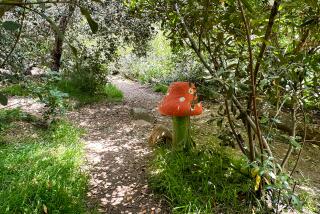Did dinosaurs stop to smell flowering plants?
It’s been a point of heated debate among scientists for years: Just when in Earth’s history did flowering plants first appear?
In a paper published recently in the journal Frontiers in Plant Science, researchers say they have discovered fossilized pollen grains that date back 243 million years -- more than 100 million years earlier than previously thought.
If true, that would suggest that flowering plants, or angiosperms, appeared at roughly the same time as dinosaurs, in the Middle Triassic period. These flowering plants would have evolved from extinct plants related to conifers, ginkgos, cycads and seed ferns.
Lead study author Peter Hochuli, a professor at the Paleontological Institute and Museum in Zurich, Switzerland, and his geologist colleague Susanne Feist-Burkhardt of Ober-Ramstadt, Germany, said the pollen was recovered from deep core samples in northern Switzerland.
The core samples contained six different types of pollen, suggesting to study authors that there may have been a great diversity of flowering plants.
The origin of flowering plants has puzzled scientists for a long time. They made a “sudden appearance” on most continents in the latter part of the early Cretaceous period.
The trouble with dating the plants has been their fragility. While fossilized pollen grains have been tough enough to survive to the present day, they are difficult to accurately identify and date.
“Some finds from the Jurassic announced with much public attention proved to be based on wrong ages and the interpretations of other remains from the Jurassic are controversial,” the authors noted.
ALSO:
Bug sex: How foul weather can ruin the mood
The Wild West world of open-access journals
That’s no crater! First explosive supervolcanoes found on Mars







